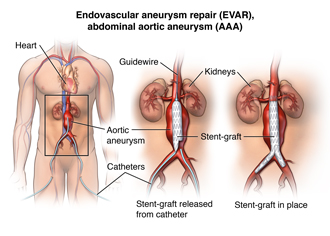Endovascular aortic aneurysms are treated by interventional radiologists by using stent-graft (metal cylinder covered with nonpermeable material) placement across the dilated part of the aorta. aortic aneurysm repair is surgery to repair a widened area in your aorta. This is called an aneurysm. The aorta is the large artery that carries blood to your belly, pelvis, and legs.
An aortic aneurysm is when a part of this artery becomes too large or balloons outward. It occurs due to weakness in the wall of the artery.
The most common location of arterial aneurysm formation is the abdominal aorta, specifically, the segment of the abdominal aorta below the kidneys. An abdominal aneurysm located below the kidneys is called an infrarenal aneurysm. An aneurysm can be characterized by its location, shape, and cause.
An aneurysm is a bulging, weak spot in the aorta that may be at risk for rupturing. In this case, the aneurysm is in part of the aorta that is in the abdomen. Repair of an AAA may be done in one of two ways:
1) Open repair
For this surgery, your doctor makes a large incision in the abdomen to expose the aorta. Once he or she has opened the abdomen, a graft can be used to repair the aneurysm. Open repair remains the standard procedure for an abdominal aortic aneurysm repair.
2) Endovascular aneurysm repair (EVAR)
This is a minimally invasive option. This means it is done without a large incision. Instead, the doctor makes a small incision in the groin. He or she will insert special instruments through a catheter in an artery in the groin and thread them up to the aneurysm. At the aneurysm, your doctor will place the stent and graft to support the aneurysm.
What is the best treatment for a thoracic aortic aneurysm?
The decision on how to treat a thoracic aneurysm of the aorta in the best possible way depends on its size and rate of growth, location, and your overall health. The risk of rupture increases when the aneurysm is larger than about twice the normal diameter of a healthy aorta blood vessel.
Medical Management
If a thoracic aneurysm is small and causes no symptoms, your physician may recommend “watchful waiting,” which includes:
1) Close monitoring of the aneurysm with CT or MRI scans every 6 months
2) Blood pressure medication to control high blood pressure.
3) decrease pressure on the weakened area of the aneurysm
4) Restriction of some physical activities. Heavy lifting should be avoided due
to increased pressure on the aorta, which may put an aneurysm at risk of
rupture
Surgery
The decision to treat a thoracic aneurysm with surgery is determined by many factors, including:
1)The presence of symptoms, including chest and back pain, and pain in the jaw,
neck and upper back
2) If the aneurysm is growing more than 1 centimeter (cm) per year
3) Signs of an aortic dissection, including sudden, severe sharp tearing pain
The age of the patient and the patient’s overall medical condition New evidence has shown that the size of the aneurysm in addition to a patient’s height plays an important role in the decision for surgery. While 5 centimeters is the size most aneurysms are considered for surgery, Cleveland Clinic surgeons have compiled years of experience and published studies to find that a patient’s height and their aneurysm’s size strongly correlates with the need for surgery. For instance, a patient who is over 6 feet tall with a 5-centimeter aneurysm would be recommended for surgery. Yet, a patient who is 5 feet 7 inches with a thoracic aneurysm of 4.7 centimeters is a candidate for surgery due to their individual risk of rupture.
Due to highly individualized characteristics guiding the decision for surgery, it is best that a physician closely monitor your thoracic aneurysm on a regular basis.

